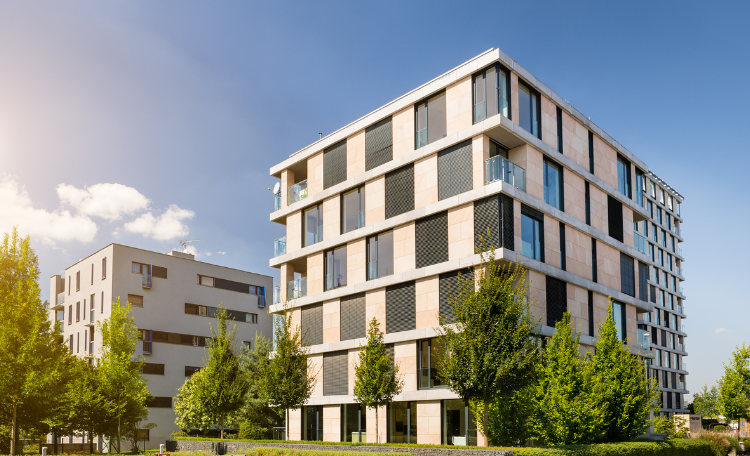
Demand for essential goods driven by COVID-19 is creating a marked uptick in online orders and a need for faster store/supply chain replenishment. Distribution centers face an unusual concurrent challenge of staffing up facilities, operating longer hours, and implementing new or augmented means of ‘social distancing’ for staff to manage the risks of potential virus contagion. Current CDC guidelines call for maintaining a physical distance of six feet (two meters) between individuals, along with updated guidelines for cleaning and disinfecting physical spaces1. The lessons learned, and creative solutions implemented during the current pandemic, will have far-reaching implications for future warehouse design considerations.
Social Distancing in the Short-Term
For quick ways to address the challenge, there are some interesting approaches being taken by some users:
- Staggered work shifts: For a distribution center designed with a traditional interior footprint, workers may be in proximity to each other for activities such as receiving goods and packing orders. Packing stations may be set up with workers closer to each other than the CDC guidelines warrant, so one way some are managing social distancing is to staff every other station on staggered work shifts, using the alternate time in between shifts to clean and disinfect the unused workstation for the next shift to use. This presents challenges in throughput and hitting trailer pull deadlines for outbound shipments but may be manageable with extended hours.
- Temporarily reconfiguring common areas or adjusting operations in work areas: Social distancing in breakrooms and supply areas (device charging stations and packaging supplies) may be addressed temporarily by spacing out tables, chairs, and microwaves, and by changing the device check-in/check-out procedures to limit the number of people touching the devices, or implementing use of gloves and additional device sanitizing procedures. In some retail settings (particularly in grocery stores), retailers are installing plexiglass food shields, more commonly known as ‘sneeze guards’ used at food buffets, to help separate cashiers from shoppers during checkout3. Some industrial users may be considering similar installations to separate workers at, for example, fixed packing stations that are not easily reconfigured for distancing guidelines, though the effectiveness of such installations may not yet be proven.
- Eliminating daily ‘stand-up’ team meetings or finding a space in the warehouse to hold meetings using CDC distancing guidelines: Many distribution or manufacturing operations use daily team meetings to communicate the shift volumes and staffing assignments. In many cases, these have been brief ‘stand-up’ meetings, held in the facility operations space, with workers often standing in a relatively tight semicircle to hear the supervisor’s communications (sometimes in a loud active operation). Holding these daily meetings while adhering to distancing guidelines may not be feasible in the given warehouse space. Some operations are temporarily halting these meetings, or finding a larger space on-site, divided out with taped markings on the floor to help workers maintain physical distance, and then staggering the scheduled use of this space for meetings.
Ways that Supply Chain and Industrial Real Estate May Change and the Challenges Ahead
While the immediate focus is on addressing ways to physically distance workers to avoid COVID-19 transmission in the facility, there are ways that technology, facility design, and operational design may help to address the future. Many experts point to updated workplace designs that may be needed long-term as the world adjusts to a ‘new normal’ that supports a healthy workforce in dense spaces.
- Implementing worker temperature checks and standard query protocols to ask if anyone has symptoms of illness: Some warehouses are already implementing mandatory daily temperature checks2 with low-tech infrared thermometers and finding ways to manage the flow of large workforces into and out of the building. Some large warehouses have experience funneling workers through a set of metal detectors for security checks and loss prevention (now a bit more challenging with the need to maintain distances of 6 feet between workers as they move through), but daily temperature checks introduce a new operational process. Technology may be able to help in the long-term, with some investment in new equipment; infrared and thermal imaging cameras are used in some airports today, scanning people for potential Elevated Body Temperature (EBT), which does not necessarily detect virus or illness, but may identify individuals warranting further consideration for potential contagious illness conditions. However, temperature checks may raise legal and privacy issues (is it legal to mandate, and how is worker health data kept private and protected?). Various countries are working to address these issues in the near and long term and you may also wish to consult with your legal advisors4.
- Design adjustments within the warehouse/factory and the potential for bigger footprints: Could the COVID-19 situation accelerate a need for long-term design considerations within industrial facilities? The footprint of an industrial facility, the material handling equipment (MHE), and flow of goods are all designed for optimal efficiency. While modern warehouse design has tapped into design efficiencies yielded by ‘going up’ for certain activities (e.g. pick modules) when ‘spreading out’ a building’s footprint may not be feasible, or is too costly, the use of more vertical space and taller clear heights may not realistically help facilitate social distancing, since those spaces are sometimes more densely staffed for efficiency.
- Acceleration of existing or innovative technology use: Will COVID-19 help to accelerate use of more robotics to help human workers avoid physical contact with each other? In some large warehouses using robotics today, workers may spend much of their shift in a relatively small area, separated from each other to cover specific stocking areas to pick orders, or crossing paths with each other infrequently; shelving robots may travel between workers to build orders or totes, or may be ferrying completed orders from the picking worker to the packing worker across the warehouse. Some functions and products are more conducive to use of such robotics, and may see increased consideration by users, but those investments come with tradeoffs of capital and maintenance costs and processes. Other products (non-conveyable) or functions (two-person trailer loading or unloading) may not be able to leverage greater use of robotics currently.
Other technologies, such as voice and optical pick devices and software, may help to reduce physical touching of common equipment, such as shelf tags/keys to confirm picks. One could also imagine using the long-existing audio technology employed by cultural institutions (e.g. museums) for walking tours to enable proximal ‘virtual’ team meetings that would allow a warehouse team to hear their supervisor discuss the day’s production goals without requiring an in-person meeting.
Balancing worker safety, operational efficiencies, and overall facility cost optimization has long challenged supply chain and industrial real estate professionals to innovate. The current COVID-19 pandemic offers new challenges and opportunities to push for solutions that will require even more collaboration as global health officials and corporations adjust to short-term needs and considerations of potential long-term changes warranted in industrial workspaces.
1 https://www.cdc.gov/coronavirus/2019-ncov/community/guidance-business-response.html



